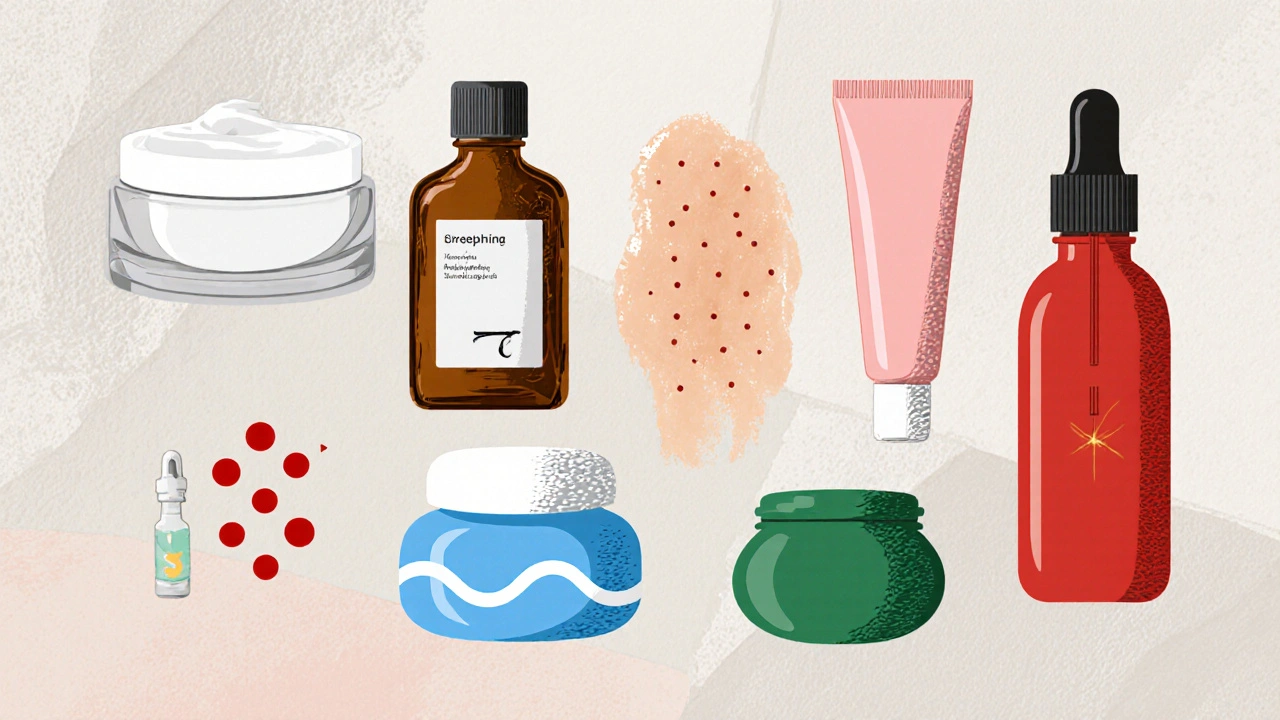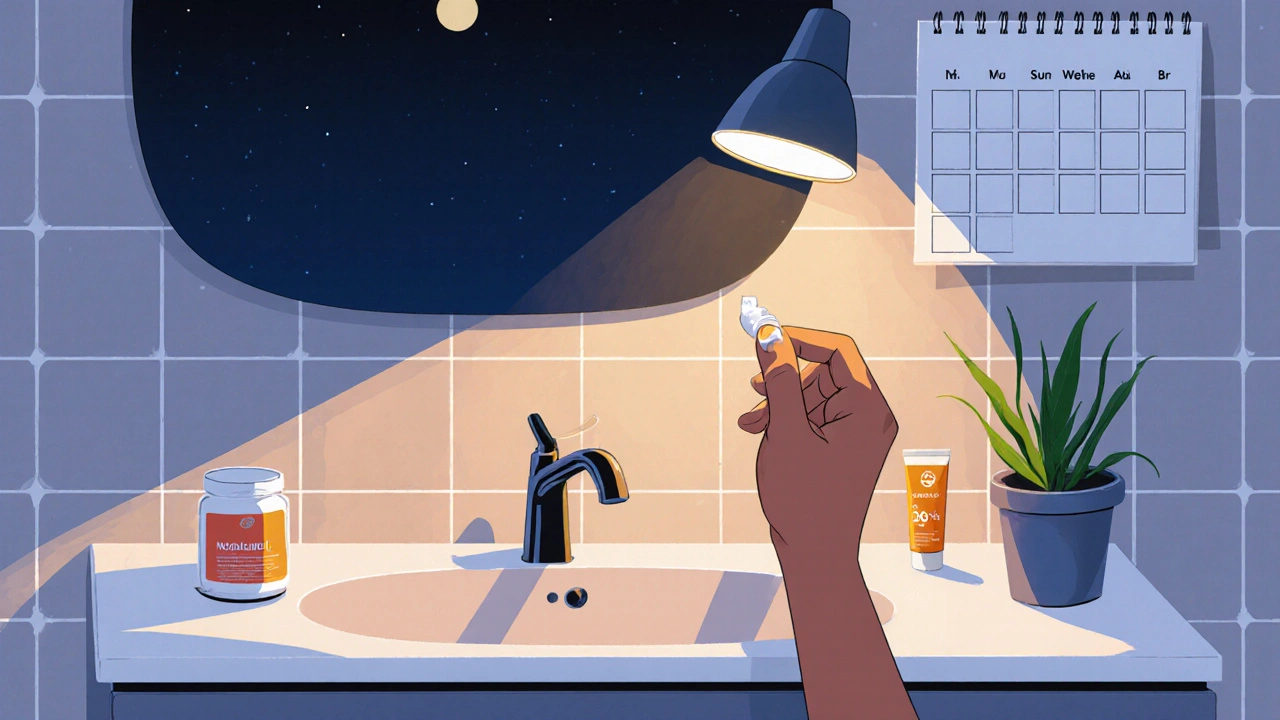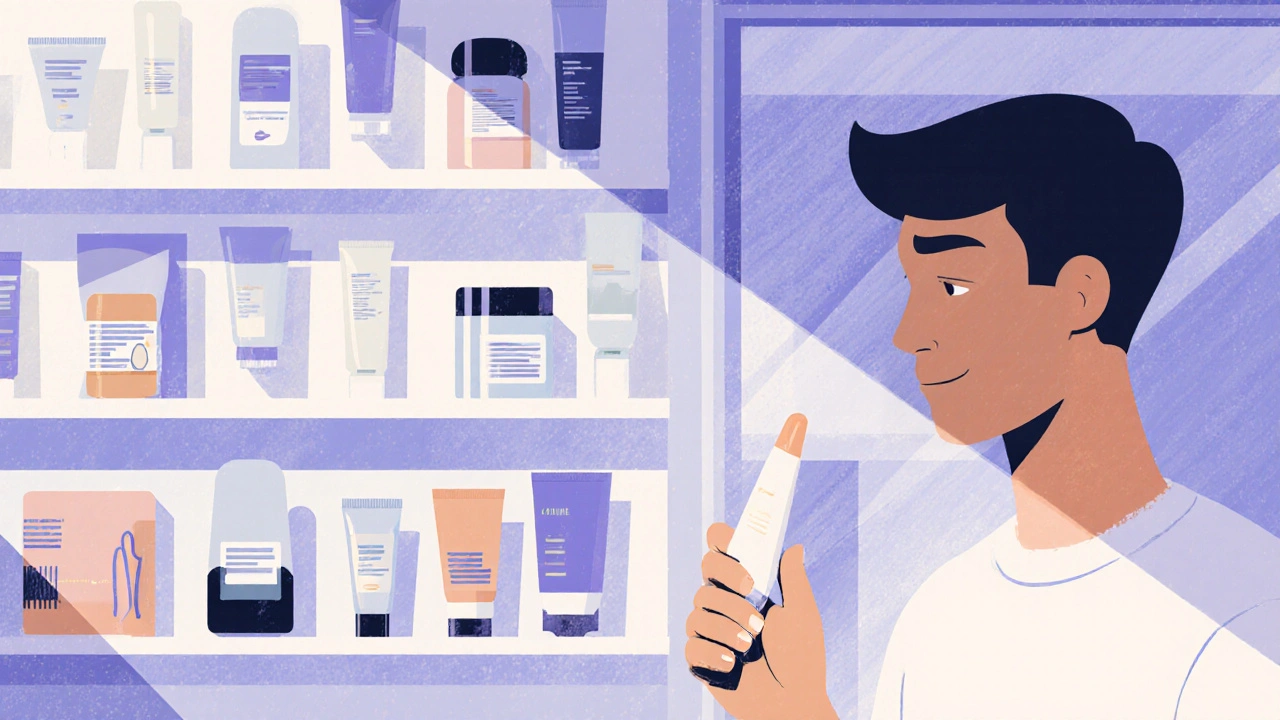Skincare Product Selector
Find Your Perfect Skincare Match
Answer three quick questions to discover which product might work best for your skin type and concerns.
Recommended Products
Important Note: This tool provides general guidance only. Always consult a dermatologist for personalized advice on skincare products.
If you’ve ever stood in the pharmacy aisle wondering whether tretinoin 0.05% is the right choice, you’re not alone. It’s a powerhouse for acne and anti‑aging, but a crowded market of alternatives can make the decision feel overwhelming. This guide breaks down how tretinoin stacks up against the most common rivals, so you can pick the formula that fits your skin goals and tolerance.
What is Tretinoin 0.05%?
Tretinoin 0.05% is a prescription‑strength retinoid derived from vitamin A. It works by speeding up cell turnover, preventing clogged pores, and stimulating collagen production. The 0.05% concentration is the typical starting dose for adults tackling mild to moderate acne or early signs of photo‑aged skin.
Why Look at Alternatives?
Retinoids can be irritating, especially when you’re new to them. Some people can’t tolerate the dryness or peeling, while others need a gentler option for maintenance after an initial tretinoin course. Knowing the trade‑offs helps you avoid wasted money and unnecessary side effects.
Top Alternatives at a Glance
- Adapalene - a synthetic retinoid often sold over‑the‑counter (OTC) in 0.1% strength.
- Retinol - a milder, OTC vitamin A derivative that needs conversion in the skin.
- Azelaic Acid - a multifunctional acid that fights acne and redness.
- Benzoyl Peroxide - a fast‑acting antibacterial for acne.
- Clindamycin - a topical antibiotic often combined with other actives.
- Niacinamide - a vitamin B3 derivative that supports barrier function.
- Salicylic Acid - a beta‑hydroxy acid that exfoliates inside pores.

Deep Dive: How Each Option Works
Adapalene binds to retinoic acid receptors much like tretinoin but with a lower irritation profile. It’s ideal for people who want retinoid benefits without a prescription. Studies in 2023 showed comparable acne clearance rates to low‑dose tretinoin after 12 weeks, but less erythema.
Retinol is a pro‑drug; skin enzymes convert it to the active retinoic acid. Because conversion is gradual, the effect is milder, making it a good first step for sensitive skin. However, you may need higher concentrations (0.5‑1%) or longer use to see anti‑aging results.
Azelaic Acid works by normalizing keratinization, killing acne‑causing bacteria, and reducing melanin production. It’s a solid alternative for rosacea‑prone skin, as it rarely causes dryness. A 2022 trial reported a 45% reduction in inflammatory lesions after eight weeks.
Benzoyl Peroxide releases oxygen to destroy *Propionibacterium acnes*. It’s fast‑acting but can bleach fabrics and cause dryness. It’s best used as a spot treatment or in combination with a retinoid.
Clindamycin reduces bacterial growth and inflammation. Resistance can develop if used alone for long periods, so dermatologists usually pair it with a retinoid or benzoyl peroxide.
Niacinamide strengthens the skin barrier, reduces transepidermal water loss, and calms redness. It doesn’t directly unclog pores but works synergistically with retinoids to offset irritation.
Salicylic Acid is oil‑soluble, allowing it to penetrate pores and dissolve sebum plugs. It’s a staple for blackheads and oily skin, often found in cleansers or leave‑on toners.
Side‑Effect Snapshot
| Ingredient | Common Irritation | Dryness | Potential Sensitization | Prescription Needed? |
|---|---|---|---|---|
| Tretinoin 0.05% | High | Moderate‑High | Low | Yes |
| Adapalene 0.1% | Medium | Low‑Medium | Low | No (OTC in many regions) |
| Retinol 0.5‑1% | Low‑Medium | Low‑Medium | Low | No |
| Azelaic Acid 15‑20% | Low | Low | Very Low | No (OTC) |
| Benzoyl Peroxide 2.5‑5% | Medium | Medium | Low | No |
| Clindamycin 1% | Low | Low | Medium (resistance) | Prescription in many countries |
| Niacinamide 4‑5% | Very Low | Very Low | Very Low | No |
| Salicylic Acid 0.5‑2% | Low‑Medium | Low‑Medium | Low | No |
Decision Criteria: Which One Fits You?
- Prescription vs. OTC: If you prefer a doctor’s oversight, tretinoin or clindamycin may be the go‑to. For hassle‑free buying, adapalene, retinol, azelaic acid, niacinamide, or salicylic acid are readily available.
- Skin Sensitivity: Highly reactive skin should start with niacinamide or azelaic acid. Those who can tolerate mild peeling may move to adapalene, then tretinoin.
- Primary Concern: For inflammatory acne, benzoyl peroxide + clindamycin or a retinoid works best. For post‑inflammatory hyperpigmentation, azelaic acid shines. For fine lines, tretinoin remains the gold standard.
- Budget & Convenience: OTC products range $10‑$30, whereas prescription retinoids can cost $50‑$150 per month depending on insurance.
- Long‑Term Plan: Many dermatologists recommend starting with a gentler agent (e.g., adapalene) and transitioning to tretinoin once tolerance builds.

Practical Tips for Safe Use
- Start slow: apply a pea‑size amount every other night for the first two weeks.
- Always follow with a fragrance‑free moisturizer to lock in water.
- Use sunscreen with SPF 30+ daily; retinoids increase sun sensitivity.
- If you experience excessive redness, cut back to twice a week and gradually increase frequency.
- Never mix multiple strong actives (e.g., benzoyl peroxide + tretinoin) in the same routine without a dermatologist’s guidance.
Quick Comparison Checklist
- Tretinoin 0.05%: Best for acne + anti‑aging, prescription‑only, higher irritation.
- Adapalene 0.1%: Good OTC retinoid, milder, suitable for beginners.
- Retinol 0.5‑1%: Gentle, over‑the‑counter, slower results.
- Azelaic Acid 15‑20%: Ideal for rosacea & hyperpigmentation, low irritation.
- Benzoyl Peroxide: Fast antibacterial, best as spot treatment.
- Clindamycin: Antibiotic, works well with a retinoid, prescription in many places.
- Niacinamide: Barrier support, excellent side‑effect buffer.
- Salicylic Acid: Pore‑deep exfoliation, great for oily skin.
Frequently Asked Questions
Can I use tretinoin and adapalene together?
Combining two retinoids doesn’t usually give extra benefit and often spikes irritation. Most dermatologists suggest alternating nights or sticking to one retinoid at a time.
How long does it take to see results with tretinoin?
Visible improvement in acne typically appears after 8‑12 weeks, while collagen‑boosting anti‑aging effects can take 4‑6 months of consistent use.
Is retinol as effective as tretinoin for wrinkles?
Retinol offers similar mechanisms but at a slower pace because it must be converted into active retinoic acid. For faster, stronger results, tretinoin remains the clinical gold standard.
Can I switch from benzoyl peroxide to a retinoid without a break?
It’s safest to taper off benzoyl peroxide for a few days before starting a retinoid, especially if you’ve experienced dry or irritated skin.
What if I develop redness from tretinoin?
Reduce application frequency (every third night), add a richer moisturizer, and ensure you’re using a broad‑spectrum SPF 30+. If redness persists beyond two weeks, consult a dermatologist.


Kimberly Lloyd
Sometimes the journey to clear skin feels like a quiet meditation, where each gentle step builds confidence. Embracing tretinoin or a gentler alternative can be an act of self‑care that honors both body and mind. Remember, patience is a virtue that the skin rewards, and the small victories accumulate into lasting glow.
parbat parbatzapada
Did you ever wonder why teh big pharma pushes tretinoin so hard it feels like a covert agenda to keep us dependent? The OTC rivals are just a distraction, they’re not really about skin health but about market control. Stay wary and read teh fine print.
Casey Cloud
Tretinoin works by increasing cell turnover which helps clear pores and boost collagen production for smoother skin. It is best to start with a pea size amount every other night and follow with a fragrance free moisturizer to reduce dryness. Consistent use with SPF 30+ will minimize sun sensitivity and improve results.
Rachel Valderrama
Oh great, another miracle cream that promises the moon-just what my wallet needed!
Brandy Eichberger
My dear skincare connoisseurs, if you truly appreciate the nuanced pharmacodynamics of retinoids, you will recognize that tretinoin 0.05% stands as the quintessence of dermatological innovation, surpassing the pedestrian allure of over‑the‑counter adaptalene with its formidable collagen‑synthesis prowess. Yet, let us not dismiss the modest charm of azelaic acid, whose gentle elegance caters to the more discerning palate seeking balance without the theatrical irritation. Feel free to explore these options with the grace of a seasoned sommelier sampling fine vintages.
Kathrynne Krause
What a vibrant tapestry you’ve woven, Brandy! 🌈 Your description paints each ingredient like a brushstroke on a canvas of radiant skin, and I love how you celebrate both the bold and the subtle notes. It’s refreshing to hear such poetic reverence for the science.
Chirag Muthoo
Esteemed members, I would like to emphasize the importance of a disciplined regimen when introducing any retinoid, particularly tretinoin. Commencing with a low frequency and employing a barrier‑supporting moisturizer can significantly mitigate adverse reactions. Moreover, consistent application of a broad‑spectrum sunscreen remains indispensable throughout the treatment course.
Xavier Lusky
While your advice sounds reasonable, one must also consider the hidden variables in modern formulations-synthetic carriers that may interact with the skin’s microbiome in ways not disclosed by manufacturers. It is prudent to question the complete transparency of these products.
Jasmina Redzepovic
Let’s cut through the fluff: domestic manufacturers produce superior tretinoin formulations that adhere to stringent FDA standards, unlike many imported OTC alternatives that cut corners on active concentration. The bioavailability metrics and epidermal penetration data unequivocally demonstrate that a properly prescribed 0.05% tretinoin outperforms any “budget” retinoid on the market. Trust the science, trust the homegrown quality.
Esther Olabisi
Wow, Jasmina, your enthusiasm for “homegrown” science is truly inspiring 😂. It’s comforting to know we have patriotic skincare heroes watching over our pores.
Ivan Laney
When evaluating the comparative efficacy of tretinoin versus its myriad alternatives, it is essential to adopt a comprehensive, data‑driven approach that encompasses not only the pharmacokinetic parameters but also the sociopolitical implications of pharmaceutical supply chains. Firstly, the molecular architecture of tretinoin, as a pure retinoic acid derivative, affords it a direct receptor affinity that bypasses the enzymatic conversion steps required by retinol, thereby yielding a more predictable dose‑response curve. Secondly, the clinical trial data published in peer‑reviewed dermatological journals consistently indicate superior outcomes in terms of both comedolysis and collagen remodeling when employing the 0.05% concentration under controlled conditions. Moreover, the ancillary benefits observed in patients with photodamage are quantifiable through objective measures such as cutaneous elasticity indices and transepidermal water loss reductions. In contrast, over‑the‑counter agents like adapalene, while possessing a favorable irritation profile, often suffer from variability in vehicle composition that can attenuate their bioavailability. Azelaic acid, though commendable for its anti‑inflammatory properties, lacks the robust retinoid signaling cascade necessary for profound anti‑aging effects. Furthermore, the economic dimension cannot be overlooked; domestically produced tretinoin formulations, when subsidized through insurance frameworks, present a cost‑effectiveness ratio that outstrips many imported OTC competitors. It is also noteworthy that the regulatory oversight exercised by national health agencies imposes stringent quality controls, thereby minimizing the risk of contamination or subpotent batches that occasionally plague less regulated markets. From a strategic perspective, encouraging a transition from transient, superficial treatments toward a sustained, evidence‑based regimen aligns with broader public health objectives aimed at reducing the cumulative burden of acne‑related complications. Additionally, patient adherence is markedly improved when educational initiatives elucidate the mechanistic rationale behind tretinoin’s superior performance, fostering a sense of informed empowerment. The cumulative body of literature, therefore, substantiates the position that tretinoin should remain the cornerstone of both acne and anti‑aging therapeutic algorithms, provided that clinicians adhere to best‑practice protocols regarding initiation, titration, and adjunctive care. Lastly, it is imperative to acknowledge that any deviation from this paradigm, motivated by marketing hype or unsubstantiated anecdotal claims, risks undermining the scientific integrity of dermatologic practice. In summary, the confluence of molecular potency, clinical efficacy, regulatory assurance, and economic rationality unequivocally endorses tretinoin as the premier choice for patients seeking durable, high‑quality skin outcomes.